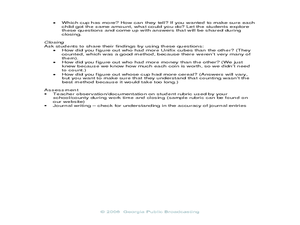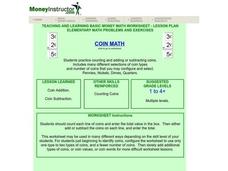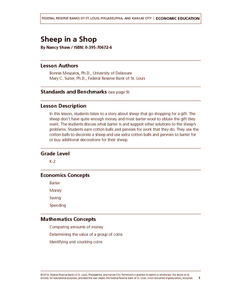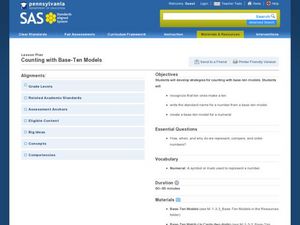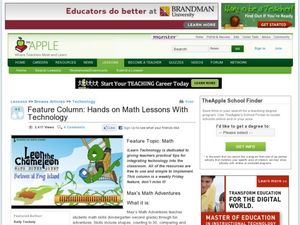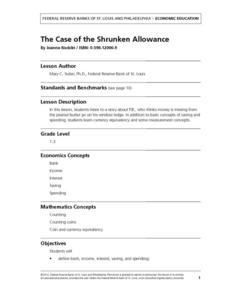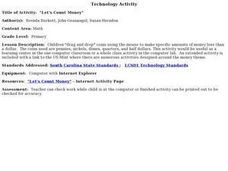Federal Reserve Bank
Bunny Money
Teach your class about saving, spending, and goal setting with a story about a couple of bunnies who went shopping and related activities. Learners keep track of the bunnies' spending, practice identifying long- and short-term savings...
Curated OER
More! A Lesson on Comparing
Students practice counting and comparing objects. In this math lesson, students view a Count on It! episode. Students examine the value of what they are counting. Students estimate number in groups of items. Students determine which...
Curated OER
Using Counting-on Strategy for Purchasing
Intended for learners with autism and developmental disabilities, this lesson uses the strategy of counting-on to enhance independent shopping skills. Learners will practice counting on to the next dollar value in order to purchase items...
Curated OER
Four Famous Faces
Each one of our quarters is embellished with a famous face or image representing the state it came from. This lesson plan uses South Dakota's state quarter to get kids thinking about monetary value, what the president of the United...
Curated OER
We're In The Money
Learn about the history of money, as well as counterfeiting, budget vocabulary, and money management. Much of the lesson requires a Nova video; however, it also includes numerous worksheets that may be useful even without the video....
State of Michigan
Pre-K Mathematics
Kick-start children's education with this pre-school math unit. Offering 31 different hands-on learning activities that develop young mathematicians' pattern and shape recognition, basic number sense, and much more, this is a must-have...
Curated OER
Quarter, Nickel, Dime....
An engaging game called, "Quarter, Nickel, and Dime" is presented in this math lesson. Players are given an envelope with slips of paper that represent the three coins. In pairs, they play the game 18 times, and the whole class charts...
Curated OER
Counting Coins
Students practice counting and adding or subtracting coins. The lesson includes many different selections of coin types and number of coins that you may configure and select. Pennies, Nickels, Dimes, Quarters are the coins used.
Curated OER
Estimating and Counting Money
Learners explore the concepts of estimating and rounding. In this estimating and rounding lesson, students play a game of tic-tac-toe. Learners pick items and must estimate their cost by rounding. Students estimate the costs of pretend...
Federal Reserve Bank
Sheep in a Shop
What do you think sheep might be able to barter when they don't have quite enough to buy a gift? Your pupils can find out this and much more during this lesson about Sheep in a Shop, spending, saving, and bartering.
Curated OER
Stamping Coins
Learners demonstrate that they can use a variety of coin combinations to make a single amount. They study all the ways to make 50 cents using coins using different coins.
Curated OER
Real-life Problems, Money, and Weight
Solve five word problems involving money and weight. After studying the example at the top, which demonstrates how to write out the equation in a word problem, fourth graders work on adding large numbers in money and measurement. Here is...
Curated OER
Counting with Base - Ten Models
Help your kids develop strategies for counting. In this base-ten lesson, learners use matching cards, base 10 blocks, and dry erase markers and boards to examine the base 10 counting system.
Curated OER
Counting Coins
Second graders identify a quarter, dime, penny, nickel, and dime. They match the coin with it's monetary value, collect data on excel spreadsheet, and create a graph in Excel. Students participate in group activities.
Curated OER
Kindergarten Numbers and Number Sense
Twelve math lessons take kindergartners through the process of number sense and counting. The skills range from counting to ten, filling out ten frames, indicating ordinal position of an object, and counting by fives and tens to one...
Curated OER
Feature column: Hands on Math With Technology
Young learners will view a math adventures video and practice math concepts. Afterwards they will navigate through Internet sites to participate in teacher selected math adventures. This guide walks you through integrating technology...
Curated OER
Nickel/Penny Grab
First graders examine the coins nickels and pennies. In this math lesson, 1st graders compare the value of the two sets of coins and determine their value. Additionally, students explore counting sets of coins that have pennies and...
Curated OER
Alexander Used to Be Rich
Reading Alexander, Who Used to Be Rich Last Sunday, launches this lesson appropriate for children who recognize coins and have been introduced to coin values. Using addition and subtraction skills, the class tracks Alexander’s spending...
Curated OER
Logic and Problem Solving: Math Hunt
In these math lesson plans, students discuss how math problems are written to reflect real-world situations. They complete an online Math Hunt using specific web tools, and work individually to create their own Math Hunts. Additionally,...
Curated OER
Count On It!
Students practice counting money. In this consumer math lesson, students identify the various U.S. coins and group them in various ways to equal a dollar. Students will use the money they collected for a donation towards a non-profit...
Curated OER
Count Dime and Pennies
In this early childhood math practice worksheet, students use problem solving skills to solve 6 story problems that require them to count coins.
Federal Reserve Bank
The Case of the Shrunken Allowance
An allowance is an important thing! Make sure your kids know how to save and spend their own money. Using the book The Case of the Shrunken Allowance as a starting point, this plan covers income, spending and saving, counting, and more.
Concord Consortium
Summertopia
What if the unit of money changes tomorrow? Would you be prepared? Learners calculate currency conversions using fictional units of money. The fictional unit's base is 60 rather than 100, which can connect to time or even degrees.
Curated OER
"Let's Count Money"
Young scholars participate in an interactive Internet activity that allows them to practice counting money. Students can work independently or cooperatively as they "drag and drop" coins using a mouse.



